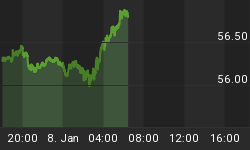The first quarter current account deficit has been released; it was higher than "the market" expected. Now $195.1 billion, an annual run rate of $780.4 billion; at this rate up 17% from the 2004 current account deficit of $665.9bn. It is the broadest measure of international transfers of goods, services, and investments. Foreigners now have to purchase over $2bn U.S. dollars a day, just to keep the currency stable. The Organization for Economic Co-operation and Development (OECD) recently warned the deficit may reach $900bn in 2006.
All of this on the backdrop that recently released inflation numbers are very tame. The consumer price index (CPI) was a bit weaker than expected as oil prices had pulled back in May. Since the end of May, however, we have gold again near $440 an ounce, we have oil above $57 a barrel.
The same picture continues: prices of goods imported from Asia remain stable. Everything that we cannot import, such as the cost of education, healthcare, or local craftsmen, is getting ever more expensive. Housing prices remain in the stratosphere.
In the meantime, analysts on Wall Street tout any news as good news: "A high dollar is good news for imports; a weak dollar is good for exports; high interest rates are a sign the economy is strong; high oil prices show that our economy is not dependent on oil; the CPI is low; Greenspan says a flat yield curve is no indication of a coming recession, it's different this time."
The only warning signs we see that not everything is perfect in this world is that gold is climbing and the dollar heading down once again. The current account deficit, in our view, is the single biggest factor that exerts long-term pressure on the dollar. To quote former European Central Bank president Duisenberg, "We hope and pray that this adjustment, which is unavoidable, will be slow and gradual."
At the Merk Hard Curency Fund, we rather focus on diversifying out of the dollar and into hard currencies than rely on the prayers of our central bankers.
















